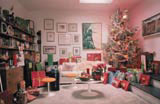Life peer
Edward Barber visits A Storybook Life at The Whitechapel, more than two decades’ worth of art photographer Philip-Lorca DiCorcia’s work

Branding is a powerful thing. In the world of art photography it can mean the difference between a set of images being viewed as a random, personal and uninteresting bunch or heralded as an important series, published as an artist’s book and premiered at one of London’s top art galleries. Philip-Lorca DiCorcia certainly has the necessary branding to carry it off with A Storybook Life at The Whitechapel.
Many of you will already be familiar with diCorcia’s work. During a 20-year period his images have been exhibited and collected all over the US and Europe. He was also shortlisted for the Citibank Photography Award. For some reason, best known to the judges, he didn’t win.
His photographs come from a documentary tradition, but he employs any means available to achieve the result he wants. He mixes lighting into scenes that are often difficult to read as either pure fiction or simple straightforward no-frills documentary. Personally, I find them unsettling, although strangely memorable. Like stills from some movie on TV I thought I saw once, falling asleep on the sofa in the early hours. Fantasy and reality are blurred.
DiCorcia has successfully marked out some spooky visual territory. He has also taken some of photography’s most powerful qualities – capturing fleeting moments, recording the interplay of light and shade, using intense colour saturation and putting them into a heady cocktail with a shot of stage management.
So it is with high expectations that I approach this previously unseen work. He is showing two series: Two Hours from a session in Havana, Cuba, which was sadly not available for preview; and A Storybook Life – fragments from an artist’s life, with more than two decades’ worth distilled into an edit of 80 images with minimal captions. Elevated into the realm of art, no longer just snaps. Now part of the artist’s ‘oeuvre’. Intimate, touching, personal moments. Cold, clinical, detached moments. Dull light, bright sun, chiaroscuro. All life is here. And so is the familiar hand of DiCorcia; interrupting, intervening, cutting into the flow of life. He is playing with us.
So who are all the people in these pictures. Family, friends, loved ones, strangers? Who knows? Who cares? DiCorcia obviously does. He has used them to construct a narrative that starts with the idyllic house in the wilderness and ends in the funeral parlour. Symbolic or what?
In between, we get street and beach scenes plus plenty of scuzzy, unkempt interiors – hotels, motels, and rented rooms with individuals usually staring into space. No one acknowledges the presence of the cameraman. He is invisible – seemingly. They take him for granted. Or perhaps they just don’t give a damn. We can only speculate – who are they and what is he to them?
We are offered all kinds of scenarios – tantalising, exciting, intriguing, mundane, embarrassing and even downright boring. But, hey, that’s life. Plus the DiCorcia branding leads us to believe there is something else going on here. Something other. Something edgy. Without that powerful brand I wonder what I would make of these images. What do they really add up to? Just another collection of private snapshots striving to make a coherent product or a serious artistic statement by one of America’s leading contemporary photographers? You decide.
Philip-Lorca DiCorcia: A Storybook Life shows at Whitchapel Art Gallery, Whitechapel High St, London E1 from 7 June-24 August
-
Post a comment




